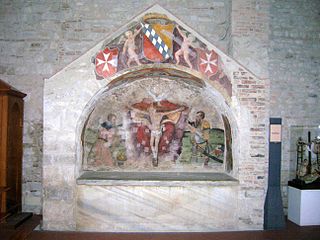Bohemond I of Antioch, also known as Bohemond of Taranto or Bohemond of Hauteville, was the prince of Taranto from 1089 to 1111 and the prince of Antioch from 1098 to 1111. He was a leader of the First Crusade, leading a contingent of Normans on the quest eastward. Knowledgable about the Byzantine Empire through earlier campaigns with his father, he was the most experienced military leader of the crusade.

RobertGuiscard, sometimes Robert "the Guiscard", also nicknamed “Terror Mundi” was a Norman adventurer remembered for the conquest of southern Italy and Sicily.

Roger I, nicknamed Roger Bosso and The Great, was a Norman nobleman who became the first Count of Sicily from 1071 to 1101. He was a member of the House of Hauteville, and his descendants in the male line continued to rule Sicily down to 1194.

The Principality of Achaea or Principality of Morea was one of the vassal states of the Latin Empire, which replaced the Byzantine Empire after the capture of Constantinople during the Fourth Crusade. It became a vassal of the Kingdom of Thessalonica, along with the Duchy of Athens, until Thessalonica was captured by Theodore, the despot of Epirus, in 1224. After this, Achaea became for a while the dominant power in Greece.
Sikelgaita was a Lombard princess, the daughter of Prince Guaimar IV of Salerno and second wife of Duke Robert Guiscard of Apulia. She commanded troops in her own right.

Philip I of Taranto, of the Angevin house, was titular Latin Emperor of Constantinople by right of his wife Catherine of Valois–Courtenay, Despot of Romania, King of Albania, Prince of Achaea and Taranto.

Roger Borsa was the Norman Duke of Apulia and Calabria and effective ruler of southern Italy from 1085 until his death.

William I of Hauteville, known as William Iron Arm, was a Norman adventurer who was the founder of the fortunes of the Hauteville family. One of twelve sons of Tancred of Hauteville, he journeyed to the Mezzogiorno with his younger brother Drogo in the first half of the eleventh century (c.1035), in response to requests for help made by fellow Normans under Rainulf Drengot, count of Aversa.

Drogo of Hauteville (c. 1010 – 10 August 1051) was the second Count of Apulia and Calabria (1046–51) in southern Italy. Initially he was only the leader of those Normans in the service of Prince Guaimar IV of Salerno, but after 1047 he was a territorial prince owing fealty directly to the Emperor.

Guaimar IV was Prince of Salerno (1027–1052), Duke of Amalfi (1039–1052), Duke of Gaeta (1040–1041), and Prince of Capua (1038–1047) in Southern Italy over the period from 1027 to 1052. He also got the submission of Naples. He was an important figure in the final phase of Byzantine authority in the Mezzogiorno and the commencement of Norman power. He was, according to Amatus of Montecassino, "more courageous than his father, more generous and more courteous; indeed he possessed all the qualities a layman should have—except that he took an excessive delight in women."

The Duchy of Gaeta was an early medieval state centered on the coastal South Italian city of Gaeta. It began in the early ninth century as the local community began to grow autonomous as Byzantine power lagged in the Mediterranean and the peninsula due to Lombard and Saracen incursions.
Richard Drengot was the count of Aversa (1049–1078), prince of Capua and duke of Gaeta (1064–1078).

Abelard of Hauteville was the eldest son of Humphrey, count of Apulia and Calabria (1051–1057), and his Lombard wife, Gaitelgrima of Salerno, also known as Altrude. He was supposed to inherit his father's lands, but Robert Guiscard, his uncle and guardian, who was elected count on Humphrey's death, confiscated them.
Peter I, also known as Petronius, was the first Norman count of Trani. He was one of the most prominent of the twelve leaders of the Norman mercenaries serving Guaimar IV of Salerno. Though it had not yet been conquered from the Byzantine Empire, Peter received Trani in the Normans' division of Apulia made at Melfi in 1042. In that same division his brother Walter received Civitate.

The Hauteville was a Norman family originally of seigneurial rank from the Cotentin. The Hautevilles rose to prominence through their part in the Norman conquest of southern Italy. By 1130, one of their members, Roger II, was made the first King of Sicily. His male-line descendants ruled Sicily until 1194. Some Italian Hautevilles took part in the First Crusade and the founding of the Principality of Antioch (1098).

The Norman conquest of southern Italy lasted from 999 to 1139, involving many battles and independent conquerors.
Peter II was the third Italo-Norman count of Trani. He was the youngest of three sons of Peter I; his elder brothers were Amico and Geoffrey.
Abulchares was a Byzantine general of Arab origin who served as the catepan of Italy from 1064 until his death. The chief sources for his catapanate are Skylitzes Continuatus and Anonymi Barensis Chronicon. Skylitzes Continuatus records that Abulchares was also duke (doux) of Dyrrhachium across the Adriatic, but this is chronologically impossible, since Perenos is recorded as duke at this time.
Joscelin was a Norman count of Molfetta on the Adriatic coast of southern Italy. He rejected the leadership of Duke Robert Guiscard and rebelled, perhaps as early as 1064, certainly by 1067. Defeated, he went over the Byzantines in 1068.
Amicus of Giovinazzo, also Amicus II, was a Norman nobleman and military leader during the Norman conquest of southern Italy. He was the count of Molfetta from 1068 until his death and of Giovinazzo from 1068 until 1073. He came from a prominent family often opposed to the rule of the Hautevilles. In 1067–68, 1072–73 and 1079–80 he took part in rebellions against the Hauteville Duke of Apulia. In 1067 and 1079 he received aid from Byzantium against the duke.











